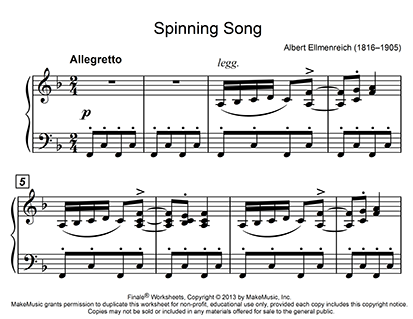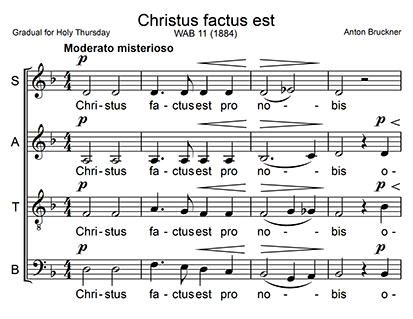Noteman says: For more information on the Modified Stave Notation standard, including the availability of samples and transcription services, visit the RNIB website and the UK Association for Accessible Format's Guidance documents (G009: Modified Stave Notation).
Persons with a ![]() print disability"A print-disabled person is anyone for whom a visual, cognitive, or physical disability hinders the ability to read print. This includes all visual impairments, dyslexia, and any physical disabilities that prevent the handling of a physical copy of a print publication."
UK Association for Accessible Formats. "G009: Modified Stave Notation", p. 5, sourced from Copyright Licensing Agency Print Disability Licensing Scheme, Guidelines for Licensees 2010. have specific needs for readable sheet music. A set of guidelines for enlarged engraving called
print disability"A print-disabled person is anyone for whom a visual, cognitive, or physical disability hinders the ability to read print. This includes all visual impairments, dyslexia, and any physical disabilities that prevent the handling of a physical copy of a print publication."
UK Association for Accessible Formats. "G009: Modified Stave Notation", p. 5, sourced from Copyright Licensing Agency Print Disability Licensing Scheme, Guidelines for Licensees 2010. have specific needs for readable sheet music. A set of guidelines for enlarged engraving called ![]() Modified Stave Notation"A term given to describe music in large print. MSN enlarges the music generally and makes a score more consistent, but it also alters the proportions involved. The spacing of notes is adjusted and other features such as articulations and expression marks may be disproportionately large."
UK Association for Accessible Formats. "G003: Creating Clear Print and Large Print Documents", p. 59ff., developed and promoted by the Royal National Institute of Blind People (RNIB), serves as a standard by which existing sheet music can be adjusted to fit the needs for the visually-impaired. While Modified Stave Notation provides a general set of rules, it is not itself a specific format, as it does not suggest particular values for enlargement or layout.
Modified Stave Notation"A term given to describe music in large print. MSN enlarges the music generally and makes a score more consistent, but it also alters the proportions involved. The spacing of notes is adjusted and other features such as articulations and expression marks may be disproportionately large."
UK Association for Accessible Formats. "G003: Creating Clear Print and Large Print Documents", p. 59ff., developed and promoted by the Royal National Institute of Blind People (RNIB), serves as a standard by which existing sheet music can be adjusted to fit the needs for the visually-impaired. While Modified Stave Notation provides a general set of rules, it is not itself a specific format, as it does not suggest particular values for enlargement or layout.
Fortunately, music notation software offers the ability to make these changes quickly and to try out various settings. Finale includes a template with a basic set of adjustments according to the Modified Stave Notation standard. However, each situation and each person will have individual requirements. While this template is a good place to start, we strongly recommend consulting with the musician for whom the sheet music is intended.
It is important to note that Modified Stave Notation involves more than simply enlarging the notes by a certain percentage. While this is an important component, the essential rules of good engraving should inform the end result, and so also alterations to the proportions of various score elements needs to be taken into account. Remember that all large-print documents using Modified Stave Notation must be "made to order": it's unlikely that one set of alterations will suffice in every circumstance.
According to the UKAAF, Modified Stave Notation "is often used to memorise the music prior to its final use in performance, analysis or whatever … it is more customary for musicians with severe visual problems to read, memorise, and play/sing from memory rather than to read and play at the same time." With Finale, you can also convert your sheet music into an on-screen notation file (with or without accompaniment) for practice purposes in SmartMusic. After you're satisfied with your alterations, you can export the Finale document as a SmartMusic file.
Below are two examples, a piano score and an SATB choral score. The Apply MSN script was run on both and small additional edits were made to existing score elements.
| Original document | Modified Stave Notation applied |
|---|---|

|

|

|

|
In these examples, there are only slight differences between the converted documents, demonstrating the need to tailor each document to the situation. Compared to the piano score, the SATB score includes the following settings:
- the left margin is slightly narrower (Page Format for Score dialog box)
- noteheads are slightly larger (Document Options - Fonts dialog box)
- dynamics always appear above the staff with a different offset (Category Designer dialog box)
- there is no additional baseline offset for tempo marks (Category Designer dialog box)
Included with your Finale installation is a Modified Stave Notation template. These steps describe how to create a new document with the predefined MSN settings. As noted in the final step these settings are a starting point: be sure to adjust them to fit the needs of the intended recipient.
- Choose File > New > Document from Template.
- In the General Templates folder, select the Modified Stave Notation (Maestro) template.
- Click Open.
- Complete the Setup Wizard and begin creating your music.
- Tweak the notational settings of the document as you go, and once again when all the music has been entered and the final layout decided.
For suggestions of individual settings to change, see To make specific alterations according to the Modified Stave Notation guidelines, below.
You can use the Apply MSN script in the FinaleScript plug-in to apply the settings you've chosen in one document to a different document.
- Open the document to which you want to apply the Modified Stave Notation settings.
- Open the Modified Stave Notation (Maestro) template or a document with the desired MSN settings.
- Choose Plug-ins > FinaleScript > FinaleScript Palette. The FinaleScript Palette appears.
- From the Script List, double-click Import > Apply MSN.
- Click Run Script.
It is important that the active document is the document with the desired settings to be copied (the one opened in step 2). To be sure this is the case, choose the Window menu and confirm that the correct document has a checkmark next to it.
Tip: If you want to apply Modified Stave Notation to multiple files at once, you can do so using FinaleScript's batch processing functionality. Simply duplicate the Import House Style script and make the necessary script changes.
In general, your custom MSN format/layout should be based on the size of an individual staff. Many individual settings for your document can be changed in the Document Options dialog box, Smart Shape Options dialog box, Category Designer dialog box, and Page Layout tool ![]() . In many cases, you'll want to increase the values that are set as the Finale defaults. Additional considerations might include:
. In many cases, you'll want to increase the values that are set as the Finale defaults. Additional considerations might include:
- How much music can the musician read in a single glance?
- What paper size, orientation, and margins should you use, and do you need to leave room for binding?
- What color paper will provide good contrast while remaining easy to read, and should you print Finale's display colors?
- What text fonts are easiest to read?
- Where should various types of markings be placed for consistency, and what exceptions to these rules should be called out in text notes at the beginning of the document?
- Have the page turns been put in convenient places with regard to performance?
- If the music has frequent rests, should you add cues from other parts?
- Will adding barline or text repeats reduce the number of pages or conversely increase the number of page turns?
- How often should measure numbers appear?


